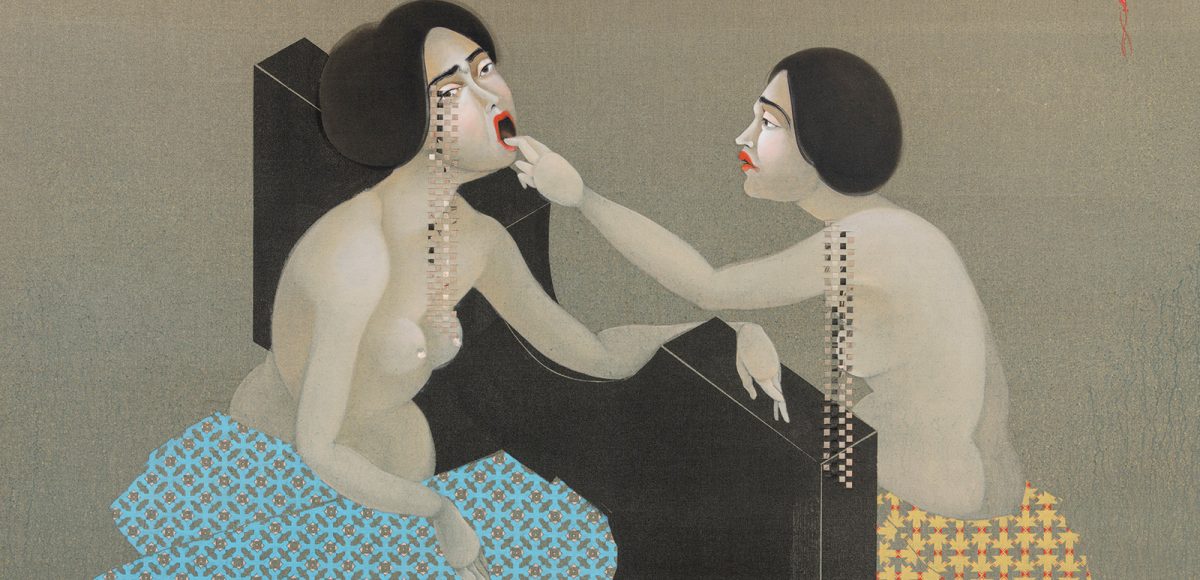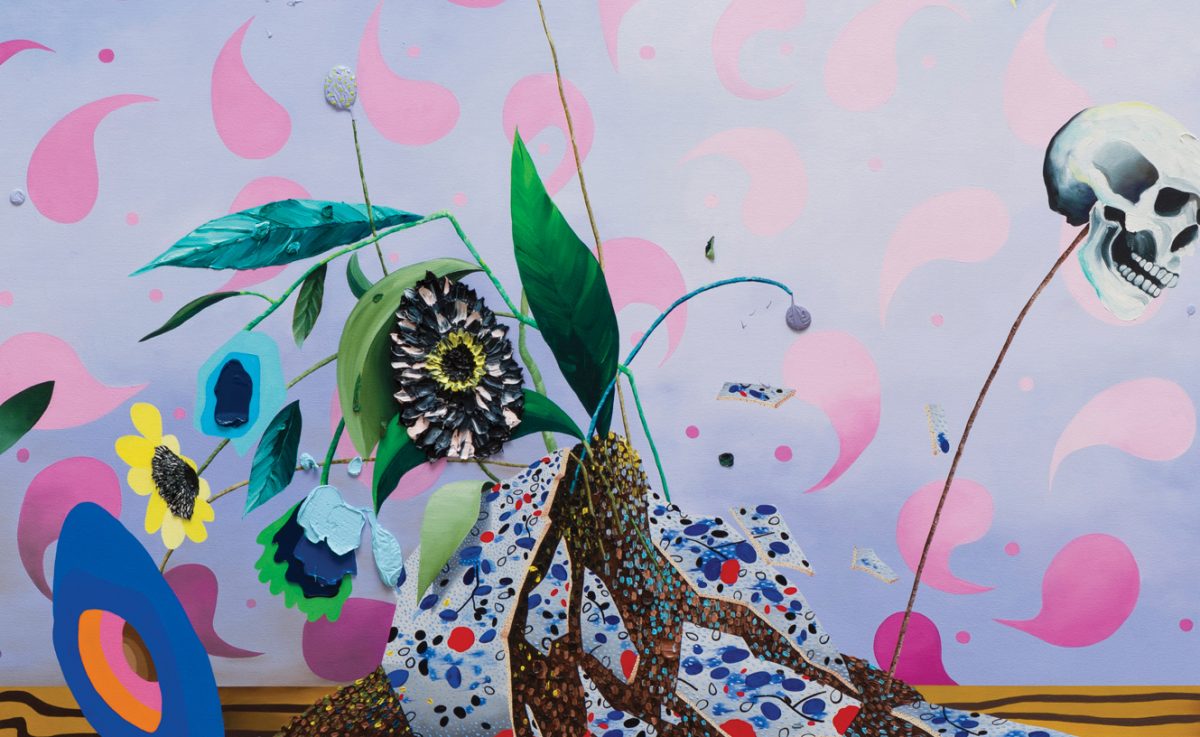Project Series 52: Hayv Kahraman
Pomona College Museum of Art
September 4—December 22, 2018
Hayv Kahraman: Silence is Gold
Susanne Vielmetter Los Angeles Projects
September 8—October 27, 2018
Beauty and suffering are inseparable in the work of Iraqi-born, Los Angeles-based artist, Hayv Kahraman. In two recent companion exhibitions, Kahraman presented idealized paintings that are seductively gorgeous, yet also alarming. Hybridizing the aesthetics of Italian Renaissance painting, Persian miniatures, Japanese woodcuts and other artistic modes, Kahraman’s images of She – a recurring female figure based on her own body – represent harrowing realities of colonization, marginalization, violence and displacement. At the same time, there is strength in these empowering images of collective females, and a remarkable sense of diasporic cultural identity.
The richness of Kahraman’s creative output is rooted in her personal story. As a child, she was part of the mass exodus of Kurds from Iraq, a direct result of Saddam Hussein’s attack on the Kurdish people in the wake of the First Gulf War. Kahraman and her family fled to Sweden, where she began making art as a child; she later studied design in Florence, Italy. While the artist acknowledges both her own suffering and that of others, her paintings do not solicit pity but preserve the dignity of their victimized subjects. Implicitly but pointedly, Kahraman’s paintings address issues of sexual violence, domestic abuse, gender inequity, racial and ethnic stereotypes, and asylum. Gross hypocrisies flourish in today’s world, and Kahraman implicates each of us to some degree.
 Hayv Kahraman, Barricade 1, 2018. Oil on linen, 50 x 78 x 3 inches. Photo by Jeff McLane. Courtesy of the artist and Susanne Vielmetter Los Angeles Projects.
Hayv Kahraman, Barricade 1, 2018. Oil on linen, 50 x 78 x 3 inches. Photo by Jeff McLane. Courtesy of the artist and Susanne Vielmetter Los Angeles Projects. Hayv Kahraman, The Kurds, 2018. Oil on linen, 98 x 76 inches. Photo by Robert Wedemeyer. Courtesy of the artist and Susanne Vielmetter Los Angeles Projects.
Hayv Kahraman, The Kurds, 2018. Oil on linen, 98 x 76 inches. Photo by Robert Wedemeyer. Courtesy of the artist and Susanne Vielmetter Los Angeles Projects.
Silence is Gold was Kahraman’s first exhibition in Los Angeles, and featured an impressive 32 paintings ranging in scale from the intimate to the expansive. Mostly oil on linen, many of the paintings employ a weaving technique derived from hand-woven fans known as mahaffa. These fans, which Kahraman describes as “an elemental symbol of Iraq,” have significance to the artist as family heirlooms. In these paintings, she recreates the woven effect by cutting into her fine-linen canvases, weaving in remnants of other paintings; simultaneously harming and mending the canvas, both literally and metaphorically. This act references past traumas endured by Kahraman and the transformations she has made in her life. Many of the paintings are titled “The Appeal.” Each of these depicts a woman contorting her body into different gestures while holding a mahaffa, an image based on a charity advertisement campaign.
Kahraman presents sexuality as a complex issue. In paintings such as “Boob Gold,” “Pussy Gold,” and the “Pussy Donation Box” series (all 2018), the female subjects confront the viewer directly, not as innocent victims but as messengers of reality. The “Pussy Donation Box” paintings have literal slits cut into the canvases, into which cash donations can be inserted. As anthropologist Miriam Ticktin explains in her essay for the exhibition, Kahraman’s paintings “echo Orientalist fantasies in places like colonial Algeria, documented in old colonial postcards, where women were featured as oppressed and imprisoned in harems, and yet their largely fictional entrapment actually served as sexual fantasy for the West.”
When victims are not sexualized, they are often depicted, critically, as the “suffering other.” Kahraman has spoken about the 1991 relief concert, “The Simple Truth: A Concert for Kurdish Refugees,” a five-hour telethon aired in 36 countries in the wake of Saddam Hussein’s genocidal attack. The artist points out that the refugees were depicted as “impoverished brown Kurdish bodies.” Her paintings, “The Celebrity,” “The Kurds” and “The Audience” include graphic spotlights, referencing the drama and artifice used to raise charitable donations. The title of Kahraman’s exhibition, Silence is Gold, suggests that many people prefer refugees to be silent. Kahraman gives them a voice.
At the closing reception for Silence is Gold, Kahraman’s performance, US and THEM, brought actual female bodies into the gallery space. Composed of dancers from The Sharon Disney Lund School of Dance at CalArts, with vocal music and choreography by CalArts faculty Jessika Kenney and Ariel Osterweis, the experience added an additional layer of richness to Kahraman’s work. The dance troupe moved throughout the gallery in a gradually intensifying display of contortions, sexualized movements and sounds, and cooperative actions.
Another collective performance by Kahraman was presented at Pomona College Art Museum, where five works by the artist were displayed in the intimate Project Series Gallery. One of these paintings, “Barricade 2” (2018), was acquired by the museum. The largest of these works was the triptych, “Read Me from Right to Left” (2017), (on loan from the WASSART Collection, Switzerland). In this piece, ten female figures in nearly identical poses stare out at the viewer. The women are set against gestural swaths of broad, inky black brushstrokes contrasting with the pristine linen ground. The figures in the left and right panels are filled entirely with mahaffa-like woven canvas strips. The piece was inspired by President Trump’s 2017 travel ban, which triggered the artist’s uncomfortable memories of her flight from Iraq as a child refugee. The title suggests that understanding people is much like reading text: just as Arabic cannot be read left-to-right like English, immigrants, migrants and refugees deserve to be understood on their own terms.









